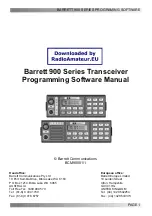
MM-014763-001, Rev. E
76
14.3 TRANSMITTING INTO A DUMMY LOAD
1.
Using the Type N male to TNC male RF coaxial jumper cable, connect the radio’s antenna connector
to the wattmeter’s input connector. Refer to Figure 14-1 as necessary.
2.
Connect the 50-ohm dummy load to the wattmeter’s output connector, in place of the antenna cable
from the vehicle-mounted antenna.
As previously stated, if conventional mode is not available per radio programming
(i.e., OTP mode is available but ECP mode is not), a peak-reading RF wattmeter is
required to measure RF transmit power. Otherwise, the use of an average-responding
wattmeter is recommended. Recommended wattmeter types are listed in Table 14-1.
3.
If not already, turn the radio on and set it to the required operating mode (based upon available radio
programming and test equipment). Refer to Section 14.1 as necessary.
4.
Set the radio to a test talk group or conventional channel, if available.
It is recommended that a test talk group/channel be allocated for this testing. This
same group should be used during the antenna test procedure which is presented in the
subsequent section.
Figure 14-1
:
Wattmeter Connections for Antenna System Tests
5.
Position the wattmeter’s slug to measure forward RF output power. Rotate it if necessary. The arrow
on the face of the slug must point away from the radio and towards the dummy load for forward
power measurements.
6.
For conventional mode transmissions
, set the wattmeter to measure average RF power.
For OpenSky mode transmissions
, set the wattmeter to measure peak RF power.
7.
Key the radio’s transmitter via the microphone’s PTT button.
Содержание M7300 Series
Страница 52: ...MM 014763 001 Rev E 52 RED RED RED WHITE RED Figure 8 4 Wiring Diagram for a Remote Mount Radio Installation ...
Страница 53: ...MM 014763 001 Rev E 53 Figure 8 4 Wiring Diagram for a Remote Mount Radio Installation Cont ...
Страница 80: ...MM 014763 001 Rev E 80 This Page Intentionally Blank ...









































